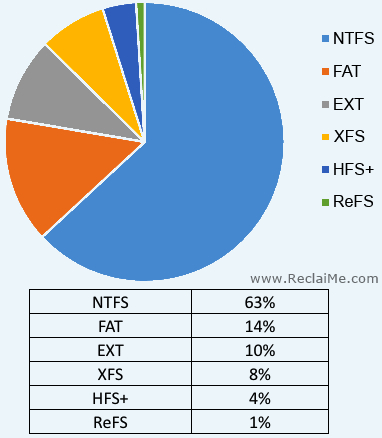NTFS Still Most Common in Data Recovery Incidents
ReclaiMe Data Recovery research
This is a Press Release edited by StorageNewsletter.com on April 9, 2014 at 2:33 pmReclaiMe Data Recovery, a data recovery software vendor, declared the results of the internal research aimed at determining most commonly recovered file systems.
The research found that NTFS still wins with more than 60% of all the incidents while the recently released ReFS is not yet popular, it takes last place with 1%. The research was conducted during 2013 and covered about 30,000 recovery incidents.
Distribution of incidents by file system type
“It is known that data recovery always lags behind development of new storage technologies since it is impossible to recover data from the device or from a filesystem which has not been invented yet,” said Elena Pakhomova, co-founder, ReclaiMe Data Recovery. “In order to somehow reduce this gap we begin to develop data recovery algorithms as soon as a new product appears on the market. This was exactly what we did with ReFS. More than a year after ReFS was released we decided to find out file system distribution among data recovery incidents.”
File system is a method of logical organization of storage. Typically each OS has its own set of file systems different in performance, limitations on the number of files, the maximum file size, and other characteristics.
Windows file systems – FAT, NTFS, and ReFS
Over the years, Microsoft have been using very few file systems, namely:
- FAT family, FAT16 and FAT32
- NTFS
- ReFS
FAT has 4GB limitation on the file size and does not provide good performance with the large set of files and folders. That makes it optimal for small (usually removable) devices, say for memory cards and external HDDs. ReclaiMe’s research revealed that FAT filesystem takes second place with 14% share and is mainly associated with memory cards and removable disks up to 500GB.
NTFS came up to replace FAT circa 1993. NTFS offers higher performance than FAT and allows use of larger capacities. NTFS is still popular and thus often to fail that reflects in first place in the research – 63% of data recovery incidents involved ReclaiMe data recovery software were associated with NTFS.
ReFS, released more than one year ago, finds itself at last place in ReclaiMe’s research with 1%. It is unlikely that this file system does not fail, most likely, it has not yet won the trust and love of home users.
Linux filesystems – EXT and XFS
Most known Linux file systems are EXT family (EXT2/3/4) and XFS.
In ReclaiMe’s statistics, Linux file systems go behind Windows filesystems. In the current research, this situation has not changed as well. Linux filesystems shown approximately even distribution between EXT and XFS – 10% and 8%, respectively. Additionally, there is UFS in Linux; however, based on the current research the file system is not popular and has not even been included in the rating. This fact mainly reflects preferences of NAS vendors in file systems, since most incidents involving Linux file systems are associated with NAS failures.
MacOS file systems – HFS and HFS+
There are only two file systems in MacOS – HFS and HFS+.
Since Apple keeps HFS only for compatibility with previously produced devices and you cannot format a new device with HFS, there are no data recovery incidents associated with HFS among the recoveries included in the current research.
As for HFS+, it takes second last place with 4% share.












 Subscribe to our free daily newsletter
Subscribe to our free daily newsletter
